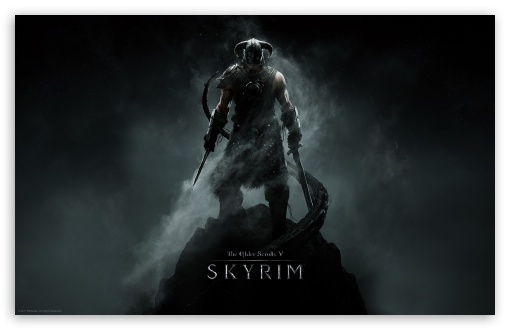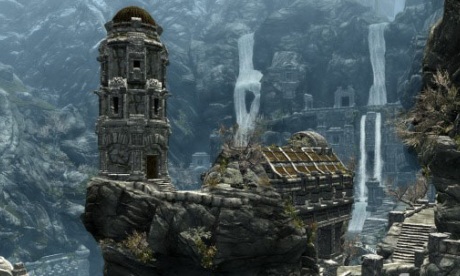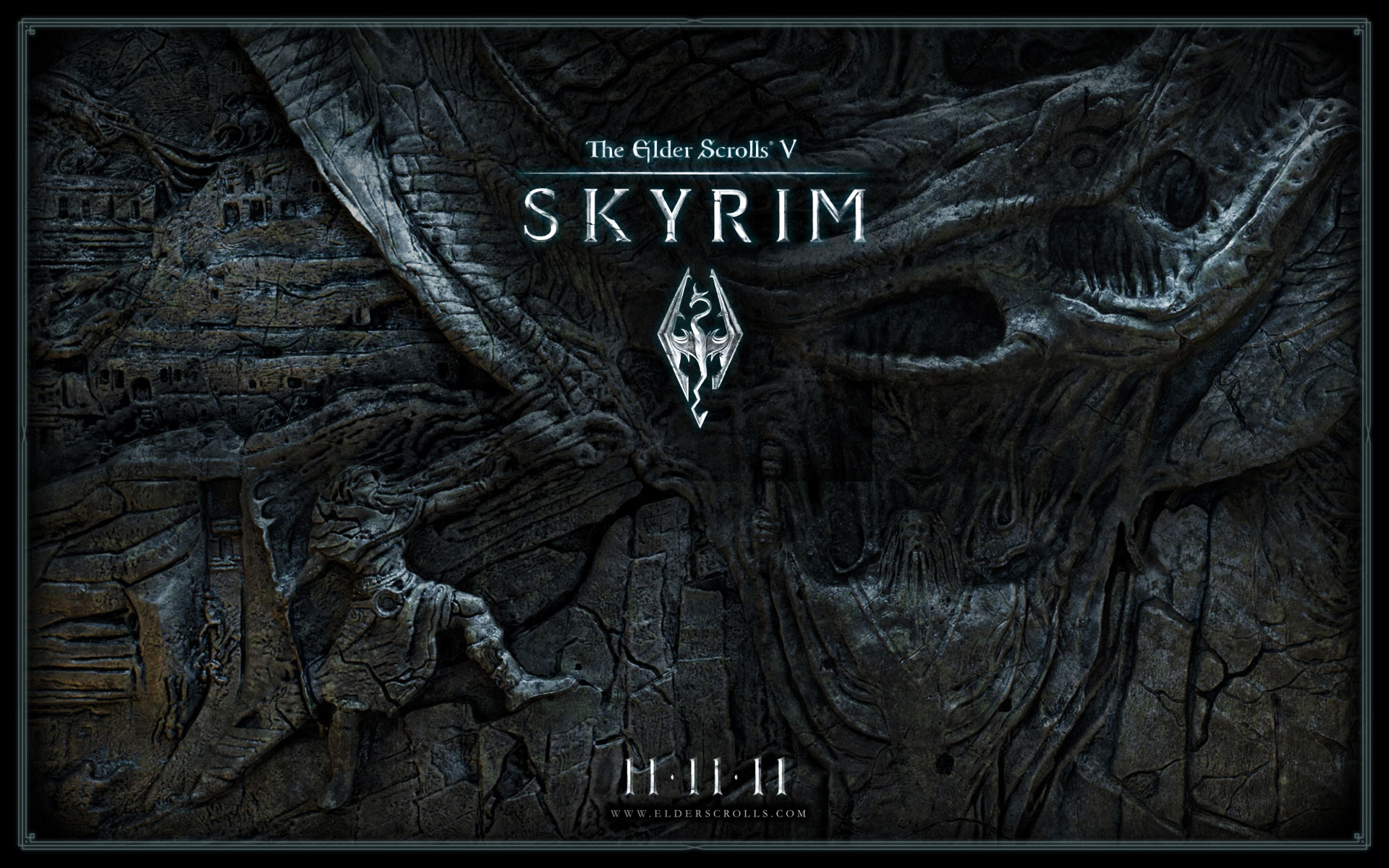Skyrim's main story revolves around the player character's efforts to defeat a dragon god who is prophesied to destroy the world. Set two hundred years after Oblivion, the game takes place in the land of Skyrim in the midst of a civil war after the assassination of the king. The open world gameplay of the Elder Scrolls series is continued in Skyrim, as the player character can explore the land at will and ignore or postpone the main quest indefinitely.
The nonlinear gameplay traditional in the Elder Scrolls series is incorporated in Skyrim. The player can explore the open world of Skyrim on-foot or on horseback, and fast-travel to cities, towns and dungeons after they have been discovered. Quests are given to the player by non-player characters (NPCs) in the world, and through the Radiant Story system, the quests can be dynamically altered to accommodate for player actions which may influence the quest's characters and objectives. The Radiant Story system further directs the player's interaction with the world by setting unexplored dungeons as quest locations. When not completing quests, the player can interact with NPCs through conversation, and they may request favors or training in skills from the player. Some NPCs can become companions to the player to aid in combat, and some companions can be married. The player may choose to join factions, which are organized groups of NPCs such as the Dark Brotherhood, a band of assassins. Each of the factions have a headquarters, and they have their own quest paths which the player can progress through. The economy of cities and towns can be stimulated by completing jobs such as farming and mining, or harmed by sabotaging industrial buildings.
When exploring the game world, the player may encounter wildlife. Many wilderness monsters are immediately hostile towards the player and thus can be slain. The inclusion of dragons in Skyrim affords a major influence on both story and gameplay. During the game's development, a team was set aside to work on dragons and their interactions with the world. In the world, a variety of different dragons are encountered either alone or in small groups. They are randomly-generated, meaning their numbers are infinite, and they can attack cities and towns at any time. Not every dragon is hostile, and the player can interact with non-hostile dragons. Early in the game, the player character learns that they are Dragonborn, which allows the player to use powerful spells called dragon shouts. Twenty different dragon shouts can be discovered by visiting "dragon walls" in dungeons, and they are unlocked for use by absorbing the souls of slain dragons. A regeneration period limits the player's use of shouts in gameplay.
Skyrim was conceptualized shortly after the release of Oblivion in 2006. To the team, it is considered a spiritual successor to their previous project Fallout 3, which was released in 2008, and Skyrim did not begin full production until after Fallout 3's release. The team of sixty people who worked on Oblivion grew to about one-hundred people by the time Skyrim entered full production. The game was directed by Todd Howard, who joined the studio in 1994 after the release of The Elder Scrolls: Arena, and who led the production of The Elder Scrolls III: Morrowind, Oblivion and Fallout 3. When development for Skyrim commenced, the team wanted to start over and build their own technology for the game. The resulting game engine was dubbed the Creation Engine, which was based on the Gamebryo engine used for Oblivion and Fallout 3, and will be utilized in the production of at least one of Bethesda's projects beyond Skyrim. After Fallout 3's release, the team devised numerous design objectives to meet for Skyrim, and as Howard described, the team "got all those done and kept going". Had the team not have been able to meet their design goals with current hardware, they would waited for the next generation and released Skyrim then, but, as Howard felt, the current technology did not hold the team back at all. The Creation Engine allowed for numerous improvements in graphical fidelity over Bethesda's previous efforts. For example, the draw distance renders farther than in previous Elder Scrolls games; Howard furnished an example where the player could stare at a small object such as a fork in detail, and then look up at a mountain and run to the top of it. Dynamic lighting affords shadows to be created by any structure or item in the game world, and while Bethesda utilized SpeedTree to produce flora in previous games, the Creation Engine was utilized for Skyrim and allowed for greater detail than what had been allowed for by SpeedTree. For example, with Bethesda's own technology, the team were able to give weight to the branches of trees which affected how the tree blew in wind; in addition, the technology afforded wind to affect the flow of water in channels such as rivers and streams. Because of the large presence of snow in Skyrim's game world, the technological upgrades were applied to weather effects and allowed for dynamical snow fall upon the terrain, instead of snow that was rendered as a textural effect in previous games.

Elder Scrolls 5

Like The Elder Scrolls,

Bethesda Wants Elder Scrolls 5

Elder Scrolls 5: Skyrum - Not

The Elder Scrolls 5: Skyrim

Download The Elder Scrolls V

The Elder Scrolls V: Skyrim

Elder Scrolls V: Skyrim:

Elder Scrolls Skyrim Combat

The Elder Scrolls 5: Skyrim

The-Elder-Scrolls-5-Skyrim-

Elder Scrolls V Skyrim logo

The Elder Scrolls 5 Skyrim

Download Elder Scrolls 5

The Elder Scrolls 5 - Skyrim

Beautiful The Elder Scrolls 5
The nonlinear gameplay traditional in the Elder Scrolls series is incorporated in Skyrim. The player can explore the open world of Skyrim on-foot or on horseback, and fast-travel to cities, towns and dungeons after they have been discovered. Quests are given to the player by non-player characters (NPCs) in the world, and through the Radiant Story system, the quests can be dynamically altered to accommodate for player actions which may influence the quest's characters and objectives. The Radiant Story system further directs the player's interaction with the world by setting unexplored dungeons as quest locations. When not completing quests, the player can interact with NPCs through conversation, and they may request favors or training in skills from the player. Some NPCs can become companions to the player to aid in combat, and some companions can be married. The player may choose to join factions, which are organized groups of NPCs such as the Dark Brotherhood, a band of assassins. Each of the factions have a headquarters, and they have their own quest paths which the player can progress through. The economy of cities and towns can be stimulated by completing jobs such as farming and mining, or harmed by sabotaging industrial buildings.
When exploring the game world, the player may encounter wildlife. Many wilderness monsters are immediately hostile towards the player and thus can be slain. The inclusion of dragons in Skyrim affords a major influence on both story and gameplay. During the game's development, a team was set aside to work on dragons and their interactions with the world. In the world, a variety of different dragons are encountered either alone or in small groups. They are randomly-generated, meaning their numbers are infinite, and they can attack cities and towns at any time. Not every dragon is hostile, and the player can interact with non-hostile dragons. Early in the game, the player character learns that they are Dragonborn, which allows the player to use powerful spells called dragon shouts. Twenty different dragon shouts can be discovered by visiting "dragon walls" in dungeons, and they are unlocked for use by absorbing the souls of slain dragons. A regeneration period limits the player's use of shouts in gameplay.
Skyrim was conceptualized shortly after the release of Oblivion in 2006. To the team, it is considered a spiritual successor to their previous project Fallout 3, which was released in 2008, and Skyrim did not begin full production until after Fallout 3's release. The team of sixty people who worked on Oblivion grew to about one-hundred people by the time Skyrim entered full production. The game was directed by Todd Howard, who joined the studio in 1994 after the release of The Elder Scrolls: Arena, and who led the production of The Elder Scrolls III: Morrowind, Oblivion and Fallout 3. When development for Skyrim commenced, the team wanted to start over and build their own technology for the game. The resulting game engine was dubbed the Creation Engine, which was based on the Gamebryo engine used for Oblivion and Fallout 3, and will be utilized in the production of at least one of Bethesda's projects beyond Skyrim. After Fallout 3's release, the team devised numerous design objectives to meet for Skyrim, and as Howard described, the team "got all those done and kept going". Had the team not have been able to meet their design goals with current hardware, they would waited for the next generation and released Skyrim then, but, as Howard felt, the current technology did not hold the team back at all. The Creation Engine allowed for numerous improvements in graphical fidelity over Bethesda's previous efforts. For example, the draw distance renders farther than in previous Elder Scrolls games; Howard furnished an example where the player could stare at a small object such as a fork in detail, and then look up at a mountain and run to the top of it. Dynamic lighting affords shadows to be created by any structure or item in the game world, and while Bethesda utilized SpeedTree to produce flora in previous games, the Creation Engine was utilized for Skyrim and allowed for greater detail than what had been allowed for by SpeedTree. For example, with Bethesda's own technology, the team were able to give weight to the branches of trees which affected how the tree blew in wind; in addition, the technology afforded wind to affect the flow of water in channels such as rivers and streams. Because of the large presence of snow in Skyrim's game world, the technological upgrades were applied to weather effects and allowed for dynamical snow fall upon the terrain, instead of snow that was rendered as a textural effect in previous games.

Elder Scrolls 5

Like The Elder Scrolls,

Bethesda Wants Elder Scrolls 5

Elder Scrolls 5: Skyrum - Not

The Elder Scrolls 5: Skyrim

Download The Elder Scrolls V

The Elder Scrolls V: Skyrim

Elder Scrolls V: Skyrim:

Elder Scrolls Skyrim Combat

The Elder Scrolls 5: Skyrim

The-Elder-Scrolls-5-Skyrim-

Elder Scrolls V Skyrim logo

The Elder Scrolls 5 Skyrim

Download Elder Scrolls 5

The Elder Scrolls 5 - Skyrim

Beautiful The Elder Scrolls 5
No comments:
Post a Comment